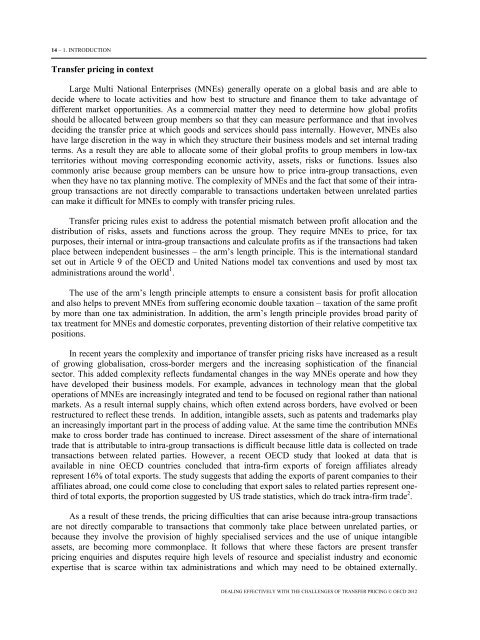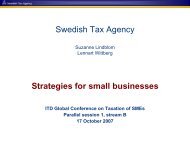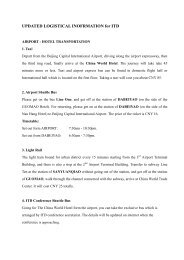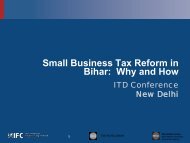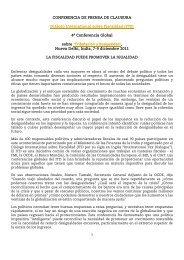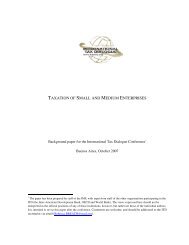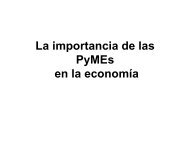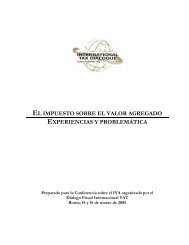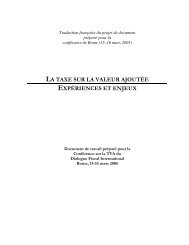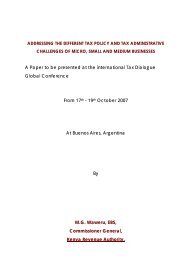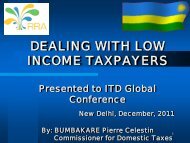Arcotia Hatsidimitris - International Tax Dialogue
Arcotia Hatsidimitris - International Tax Dialogue
Arcotia Hatsidimitris - International Tax Dialogue
You also want an ePaper? Increase the reach of your titles
YUMPU automatically turns print PDFs into web optimized ePapers that Google loves.
14 – 1. INTRODUCTION<br />
Transfer pricing in context<br />
Large Multi National Enterprises (MNEs) generally operate on a global basis and are able to<br />
decide where to locate activities and how best to structure and finance them to take advantage of<br />
different market opportunities. As a commercial matter they need to determine how global profits<br />
should be allocated between group members so that they can measure performance and that involves<br />
deciding the transfer price at which goods and services should pass internally. However, MNEs also<br />
have large discretion in the way in which they structure their business models and set internal trading<br />
terms. As a result they are able to allocate some of their global profits to group members in low-tax<br />
territories without moving corresponding economic activity, assets, risks or functions. Issues also<br />
commonly arise because group members can be unsure how to price intra-group transactions, even<br />
when they have no tax planning motive. The complexity of MNEs and the fact that some of their intragroup<br />
transactions are not directly comparable to transactions undertaken between unrelated parties<br />
can make it difficult for MNEs to comply with transfer pricing rules.<br />
Transfer pricing rules exist to address the potential mismatch between profit allocation and the<br />
distribution of risks, assets and functions across the group. They require MNEs to price, for tax<br />
purposes, their internal or intra-group transactions and calculate profits as if the transactions had taken<br />
place between independent businesses – the arm’s length principle. This is the international standard<br />
set out in Article 9 of the OECD and United Nations model tax conventions and used by most tax<br />
administrations around the world 1 .<br />
The use of the arm’s length principle attempts to ensure a consistent basis for profit allocation<br />
and also helps to prevent MNEs from suffering economic double taxation – taxation of the same profit<br />
by more than one tax administration. In addition, the arm’s length principle provides broad parity of<br />
tax treatment for MNEs and domestic corporates, preventing distortion of their relative competitive tax<br />
positions.<br />
In recent years the complexity and importance of transfer pricing risks have increased as a result<br />
of growing globalisation, cross-border mergers and the increasing sophistication of the financial<br />
sector. This added complexity reflects fundamental changes in the way MNEs operate and how they<br />
have developed their business models. For example, advances in technology mean that the global<br />
operations of MNEs are increasingly integrated and tend to be focused on regional rather than national<br />
markets. As a result internal supply chains, which often extend across borders, have evolved or been<br />
restructured to reflect these trends. In addition, intangible assets, such as patents and trademarks play<br />
an increasingly important part in the process of adding value. At the same time the contribution MNEs<br />
make to cross border trade has continued to increase. Direct assessment of the share of international<br />
trade that is attributable to intra-group transactions is difficult because little data is collected on trade<br />
transactions between related parties. However, a recent OECD study that looked at data that is<br />
available in nine OECD countries concluded that intra-firm exports of foreign affiliates already<br />
represent 16% of total exports. The study suggests that adding the exports of parent companies to their<br />
affiliates abroad, one could come close to concluding that export sales to related parties represent onethird<br />
of total exports, the proportion suggested by US trade statistics, which do track intra-firm trade 2 .<br />
As a result of these trends, the pricing difficulties that can arise because intra-group transactions<br />
are not directly comparable to transactions that commonly take place between unrelated parties, or<br />
because they involve the provision of highly specialised services and the use of unique intangible<br />
assets, are becoming more commonplace. It follows that where these factors are present transfer<br />
pricing enquiries and disputes require high levels of resource and specialist industry and economic<br />
expertise that is scarce within tax administrations and which may need to be obtained externally.<br />
DEALING EFFECTIVELY WITH THE CHALLENGES OF TRANSFER PRICING © OECD 2012


